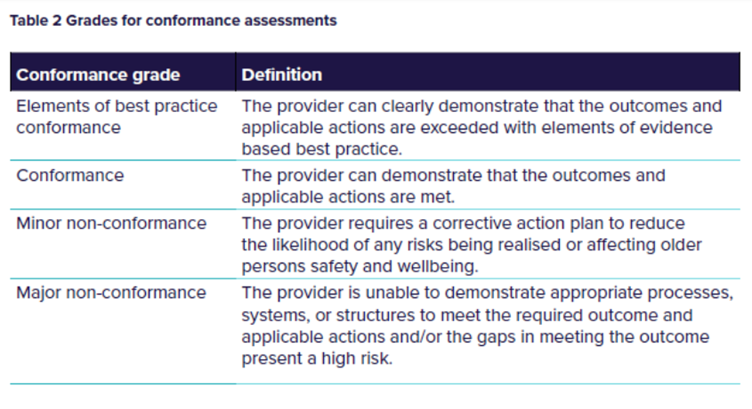As part of the ongoing consultation on the regulatory framework for aged care, the Department of Health and Aged Care provided resources on the design of the upcoming new regulatory model.
In this article we summarise the key concepts and insights from the resources to help you prepare for the commencement of the new regulatory model in July 2025 (if not before).
Foundations of the new regulatory model
According to the Department of Health and Aged Care, the new model’s four foundations build an approach that is:
- Rights-based
- Person-centred
- Risk-proportionate and
- Focused on continuous improvement.
To deliver consistent, high-quality care to older people, the model will:
- Promote cultural change across the sector
- Implement relationship-based regulation to foster:
- Stronger working relationships
- Deeper trust and
- more transparency in the sector.
Monitoring and enforcement: The “safeguards”
The model includes four “safeguards” that use a range of regulatory tools to monitor and enforce providers’ compliance with their requirements.
Figure 1 below shows the four “safeguards” – the range of regulatory tools and functions that will be used to help achieve these goals:

1. Supporting quality care
This safeguard emphasises on relational regulation to drive cultural change and improve care outcomes, creating a collaborative environment for providers to engage with the Regulator on innovation and continuous improvement. Key features include:
- Audits against strengthened Quality Standards with graded assessments.
- Encouraging providers to share improvement plans with older people and their representatives.
- Collaboration with consumer and quality advisory bodies to sustain improvements.
Incentives for high-quality care include:
- Performance reporting for transparency.
- Recognition of good performance to enhance public trust.
- Graded assessments in the new audit process.
- Right-touch regulation for high performers.
2. Becoming a provider
The new model proposes universal provider registration and re-registration, replacing the current “Approved Provider” arrangements. Key features include:
- Applicability to all providers delivering Commonwealth subsidised aged care services.
- Allowing non-corporations (e.g., sole traders and partnerships) to register for in-home aged care services.
- Six proposed registration categories based on service characteristics, risks, and provider obligations.
The proposed six registration categories are:

Table 2 below shows the grades for conformance assessments under the new audit process:

3. Responsibilities of a provider
Provider responsibilities will be known as obligations in the new model. It is proposed that provider obligations in the new model be broadly grouped by:
- Overarching obligations that all providers must comply with regardless of conditions of registration.
- Core conditions of registration that apply to all providers regardless of the services being delivered, with evidence requirements and implementation of some conditions differing based on the registration category.
- Category-specific conditions of registration that apply to some providers based on their registration category.
- Provider-specific conditions of registration which are determined by the Regulator to manage risks associated with specific providers.
Figure 2 below shows the proposed approach and demonstrates how the registration categories and obligations are linked to enable risk-proportionate regulation.

4. Holding providers accountable
The new Act will prioritise the protection and promotion of older people’s rights, encouraging them to exercise their rights and providing pathways to uphold them. Key aspects include:
- Risk-based monitoring of high-risk providers.
- Building a culture that values feedback and complaints.
- Safe, accessible, and culturally appropriate pathways to provide feedback and raise complaints.
- Restorative justice processes.
- Improved complaints and feedback mechanisms, including protections for whistle-blowers.
Transitioning to the New Model
It is proposed there will be a single ‘go-live’ commencement date, where the existing regulatory framework ceases and the new model commences. Existing providers of Commonwealth funded aged care programs will be deemed registered into relevant categories. Registration periods will be staggered to avoid simultaneous re-registration for all providers. Transition arrangements will ensure continuity of care and minimise impact on providers.
The Department of Health and Aged Care is now considering and analysing all feedback and will release a consultation report outlining what was heard during Stage 3 consultations.
Authors
Nicole Chen
Nicole is a Principal Consultant at Ideagen CompliSpace with a background in the healthcare industry across acute, aged, and community services. Throughout her career, she has held various management and clinical positions, contributing significantly to both research and higher education within the sector. Nicole provides valuable knowledge and insights from both a clinical perspective and a nuanced understanding of the operational and strategic aspects of healthcare. She holds a Doctor of Philosophy (PhD), a Postgraduate Certificate and a Bachelor in Nursing.
Nick Edwards
Nick is a Legal Content Senior Associate at Ideagen CompliSpace. Nick has several years' experience designing and administering eLearning for the Aged Care Sector and holds a Bachelor of Laws from the University of Technology Sydney with First Class Honours.








